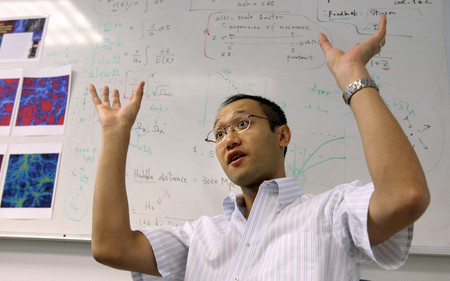Astronomer puzzles over universe
Ken Nagamine is trying to figure out where you came from. Specifically, where the molecules that make up your body came from, or at least how they came together to form a person.
He wants to know the origins of the Earth, the sun, the galaxies, the supermassive black holes and the exploding stars and the space gases and the atoms within those gases. How did all that stuff come together to form things?
He's studying all this from a closet-sized office at the University of Nevada, Las Vegas, with a computer screen the size of a nice TV. He's doing this, too, with half his brain tied behind his back, by his estimate.
But Nagamine, 35, an assistant professor of astronomy who is originally from Japan, is also doing it with a $450,000 grant from the National Science Foundation, which helps pay for extra brains -- about 4.5 extra brains, again, by his calculation.
Those extra brains belong to student researchers who get paid through the grant.
The grant, officially, allows Nagamine to study black hole feedback and galaxy formation -- a unique enough goal from an admittedly young and comparatively inexperienced researcher that he was able to snag an ultra-competitive NSF grant.
The grant, which runs for three years, also covers many other things: general upkeep of the university (about 46 percent of the money), a good portion of Nagamine's own pay (about 15 percent), travel expenses, publication expenses, and so on.
So, for Nagamine's state salary of $72,072, the university gets that back several times over because of the grant. In addition, he's employing a post-doctoral student at a hefty salary, a couple of graduate students and five undergraduate students.
Which means that, in addition to being a teacher of introductory astronomy and a researcher studying the Big Questions of the Universe, Nagamine is also a small business.
And, say university officials, he is pretty typical of young science faculty members at the university.
Though not all of them are working with large federal grants, the university's leaders say many of them are. Last year, the university brought in $40 million in research funding. Though that's not much when compared to major research institutions, researchers point out that $40 million is still a lot of money.
Typically, as in Nagamine's case, nearly half of grant funding goes directly to the university. The rest pays for research assistants, equipment and the like.
And, said UNLV President Neal Smatresk, the latest in a line of UNLV presidents who want the university to focus more on research, there are other benefits, too.
"Maybe, just maybe, we're solving some real problems," he said.
Take Carl Reiber, a professor and the associate dean of the College of Sciences.
Reiber is about to launch a research project studying zebrafish in such a way that it might, he hopes, lead to a treatment for children with a rare chromosomal disorder called Williams syndrome.
The potential practical benefits from that and other research also translates to the classroom. It keeps Reiber and his graduate assistants up on the latest developments in the field, which they bring into the classroom.
The same goes for Nagamine.
He came to the United States for graduate school, studying at Princeton and Harvard universities before joining UNLV in 2006.
He uses data gathered by astronomers all over the world. He feeds it into complicated computer programs, adds and subtracts a variable here and there, and tries to figure out how the universe ended up the way it is.
From the big bang onward, apparently random particles have gathered together to make everything that we know exists. And it's still going on.
He tries to simulate a supernova -- that's an exploding star -- in his computer to see what happens.
"We're basically trying to understand the origin of all the structures in the universe," he said. "Including us."
He figures he has three duties as a professor: teaching, research and other, which includes advising and lecturing outside the university.
"It's a really time-demanding job," he said.
But with the grant, he gets all those extra brains: the student researchers.
That is the crux of why the university has been striving toward a more research-oriented approach.
Though Smatresk acknowledged that the goal is still a long way off, and that it may be delayed during the state's ongoing budget crisis, he said the university is making steady progress.
Total external funding -- that's grants and contracts, largely -- topped $76 million last year, up almost 4 percent from the year before.
Smatresk said the university is trying to make "high impact" hires only right now, recruiting the kind of professors who not only will conduct great research, but who will enhance the university's reputation.
Imagine, he said, if UNLV were to become the major research institution its leaders have been working toward making it for the last decade. What then?
Why, more Ken Nagamines, of course.
Contact reporter Richard Lake at rlake @reviewjournal.com or 702-383-0307.
SPENDING ESTIMATE
Ken Nagamine's estimate of where the $449,317 National Science Foundation grant is spent
• university overhead, 46 percent
• postdoctoral student salary, 30 percent
• faculty summer salary, 15 percent
• graduate research assistants, 3 percent
• undergraduate research assistants, 1 percent
• travel, equipment and publication, 5 percent

















